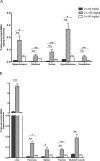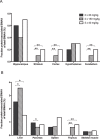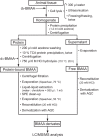Environmental neurotoxin interaction with proteins: Dose-dependent increase of free and protein-associated BMAA (β-N-methylamino-L-alanine) in neonatal rat brain
- PMID: 26498001
- PMCID: PMC4620439
- DOI: 10.1038/srep15570
Environmental neurotoxin interaction with proteins: Dose-dependent increase of free and protein-associated BMAA (β-N-methylamino-L-alanine) in neonatal rat brain
Abstract
β-Methylamino-L-alanine (BMAA) is implicated in the aetiology of neurodegenerative disorders. Neonatal exposure to BMAA induces cognitive impairments and progressive neurodegenerative changes including intracellular fibril formation in the hippocampus of adult rats. It is unclear why the neonatal hippocampus is especially vulnerable and the critical cellular perturbations preceding BMAA-induced toxicity remains to be elucidated. The aim of this study was to compare the level of free and protein-associated BMAA in neonatal rat brain and peripheral tissues after different exposures to BMAA. Ultra-high performance liquid chromatography-tandem mass spectrometry analysis revealed that BMAA passed the neonatal blood-brain barrier and was distributed to all studied brain areas. BMAA was also associated to proteins in the brain, especially in the hippocampus. The level in the brain was, however, considerably lower compared to the liver that is not a target organ for BMAA. In contrast to the liver there was a significantly increased level of protein-association of BMAA in the hippocampus and other brain areas following repeated administration suggesting that the degradation of BMAA-associated proteins may be lower in neonatal brain than in the liver. Additional evidence is needed in support of a role for protein misincorporation in the neonatal hippocampus for long-term effects of BMAA.
Figures



Similar articles
-
Protein association of the neurotoxin and non-protein amino acid BMAA (β-N-methylamino-L-alanine) in the liver and brain following neonatal administration in rats.Toxicol Lett. 2014 Apr 7;226(1):1-5. doi: 10.1016/j.toxlet.2014.01.027. Epub 2014 Jan 26. Toxicol Lett. 2014. PMID: 24472610
-
Selective brain uptake and behavioral effects of the cyanobacterial toxin BMAA (beta-N-methylamino-L-alanine) following neonatal administration to rodents.Toxicol Sci. 2009 Jun;109(2):286-95. doi: 10.1093/toxsci/kfp062. Epub 2009 Mar 25. Toxicol Sci. 2009. PMID: 19321797
-
MALDI imaging delineates hippocampal glycosphingolipid changes associated with neurotoxin induced proteopathy following neonatal BMAA exposure.Biochim Biophys Acta Proteins Proteom. 2017 Jul;1865(7):740-746. doi: 10.1016/j.bbapap.2016.12.004. Epub 2016 Dec 9. Biochim Biophys Acta Proteins Proteom. 2017. PMID: 27956354 Free PMC article.
-
Dietary exposure and neurotoxicity of the environmental free and bound toxin β-N-methylamino-l-alanine.Food Res Int. 2017 Oct;100(Pt 1):1-13. doi: 10.1016/j.foodres.2017.07.033. Epub 2017 Jul 20. Food Res Int. 2017. PMID: 28873667 Review.
-
Mechanisms of beta-N-methylamino-L-alanine induced neurotoxicity.Amyotroph Lateral Scler. 2009;10 Suppl 2:56-60. doi: 10.3109/17482960903269062. Amyotroph Lateral Scler. 2009. PMID: 19929733 Review.
Cited by
-
Reference compounds for alternative test methods to indicate developmental neurotoxicity (DNT) potential of chemicals: example lists and criteria for their selection and use.ALTEX. 2017;34(1):49-74. doi: 10.14573/altex.1604201. Epub 2016 Jul 25. ALTEX. 2017. PMID: 27452664 Free PMC article.
-
Cellular and Molecular Aspects of the β-N-Methylamino-l-alanine (BMAA) Mode of Action within the Neurodegenerative Pathway: Facts and Controversy.Toxins (Basel). 2017 Dec 22;10(1):6. doi: 10.3390/toxins10010006. Toxins (Basel). 2017. PMID: 29271898 Free PMC article. Review.
-
Melatonin Promotes Brain-Derived Neurotrophic Factor (BDNF) Expression and Anti-Apoptotic Effects in Neonatal Hemolytic Hyperbilirubinemia via a Phospholipase (PLC)-Mediated Mechanism.Med Sci Monit. 2017 Dec 16;23:5951-5959. doi: 10.12659/msm.907592. Med Sci Monit. 2017. PMID: 29247156 Free PMC article.
-
The cyanobacterial neurotoxin β-N-methylamino-L-alanine (BMAA) targets the olfactory bulb region.Arch Toxicol. 2020 Aug;94(8):2799-2808. doi: 10.1007/s00204-020-02775-6. Epub 2020 May 20. Arch Toxicol. 2020. PMID: 32435914 Free PMC article.
-
Assessing Environmental Exposure to β-N-Methylamino-L-Alanine (BMAA) in Complex Sample Matrices: a Comparison of the Three Most Popular LC-MS/MS Methods.Neurotox Res. 2018 Jan;33(1):43-54. doi: 10.1007/s12640-017-9764-3. Epub 2017 Jun 22. Neurotox Res. 2018. PMID: 28643233
References
-
- Spencer P. S. et al. Guam amyotrophic lateral sclerosis-parkinsonism-dementia linked to a plant excitant neurotoxin. Science 237, 517–522 (1987). - PubMed
-
- Murch S. J., Cox P. A., Banack S. A., Steele J. C. & Sacks O. W. Occurrence of beta-methylamino-l-alanine (BMAA) in ALS/PDC patients from Guam. Acta Neurol Scand 110, 267–269 (2004). - PubMed
Publication types
MeSH terms
Substances
LinkOut - more resources
Full Text Sources
Other Literature Sources

